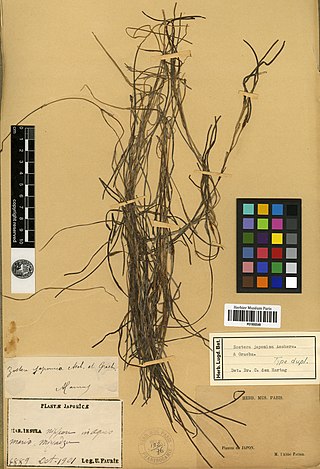Related Research Articles

Ephedra distachya is a shrub in the family Ephedraceae that stands about 25 cm to 50 cm high. The shrub grows in many parts of the world, including southern and central Europe and western and central Asia. Its local names include somlatha. Ephedra distachya lives on grey dunes which are fixed and stable sand dunes that are covered in continuous vegetation.

Vicia sativa, known as the common vetch, garden vetch, tare or simply vetch, is a nitrogen-fixing leguminous plant in the family Fabaceae. It is now naturalised throughout the world occurring on every continent, except Antarctica and the Arctic. The centre of diversity is thought to be the Fertile Crescent, although gold standard molecular confirmation is currently not available.

Crinum is a genus of about 180 species of perennial plants that have large showy flowers on leafless stems, and develop from bulbs. They are found in seasonally moist areas, including marshes, swamps, depressions and along the sides of streams and lakes in tropical and subtropical areas worldwide.

Luzula is a genus of flowering plants in the rush family Juncaceae. The genus has a cosmopolitan distribution, with species occurring throughout the world, especially in temperate regions, the Arctic, and higher elevation areas in the tropics. Plants of the genus are known commonly as wood-rush, wood rush, or woodrush. Possible origins of the genus name include the Italian lucciola or the Latin luzulae or luxulae, from lux ("light"), inspired by the way the plants sparkle when wet with dew. Another etymology sometimes given is that it does derive from lucciola but that this meant a mid-summer field, or from the Latin luculus, meaning a small place; the same source also states that this name was applied by Luigi Anguillara in 1561.

Vicia is a genus of over 240 species of flowering plants that are part of the legume family (Fabaceae), and which are commonly known as vetches. Member species are native to Europe, North America, South America, Asia and Africa. Some other genera of their subfamily Faboideae also have names containing "vetch", for example the vetchlings (Lathyrus) or the milk-vetches (Astragalus). The lentils are included in genus Vicia, and were formerly classified in genus Lens. The broad bean is sometimes separated in a monotypic genus Faba; although not often used today, it is of historical importance in plant taxonomy as the namesake of the order Fabales, the Fabaceae and the Faboideae. The tribe Vicieae in which the vetches are placed is named after the genus' current name. The true peas (Pisum) are among the closest living relatives of vetches.

Spergularia is a genus in the family Caryophyllaceae, containing salt-tolerant plants known as sandspurrys and sea-spurreys. There are about 60 species.

Patersonia, is a genus of plants whose species are commonly known as native iris or native flag and are native to areas from Malesia to Australia.

Anthyllis is a genus of flowering plants in the family Fabaceae. This genus contains both herbaceous and shrubby species and is distributed in Europe, the Middle East and North Africa. The most widespread and familiar species is A. vulneraria, a familiar grassland flower which has also been introduced to New Zealand.

Dactylis glomerata is a species of flowering plant in the grass family Poaceae, known as cock's-foot, also colloquially as orchard grass, or cat grass (due to its popularity for use with domestic cats). It is a cool-season perennial C3 tufted grass native throughout most of Europe, temperate Asia, and northern Africa.
Aegilops kotschyi is a member of the grass family, Poaceae, native to the Levant.

Avena brevis, the short oat, is a species of grass in the family Poaceae whose seeds are edible.
Periballia is a genus of Mediterranean plants in the grass family.

Coluria is a plant genus in the sub family Rosoideae native to Asia, Siberia and Altai.

Moraea aristata is a species of flowering plant in the family Iridaceae. It is referred to by the common names blue-eyed uintjie or Blouooguintjie in Afrikaans.It is endemic to the city of Cape Town and is considered to be critically endangered.

Zostera japonica is a species of aquatic plant in the Zosteraceae family. It is referred to by the common names dwarf eelgrass or Japanese eelgrass, and is native to the seacoast of eastern Asia from Russia to Vietnam, and introduced to the western coast of North America. It is found in the intertidal zone and the shallow subtidal, and grows on sandy, muddy and silty substrates.

Althenia preissii is a plant found in fresh to brackish waters in Australia. This species has been transferred from the genus Lepilaena.

Geissorhiza ovata is a species of flowering plant in the family Iridaceae. It is found growing on stone ridges and rock outcrops in the Northern Cape Province of South Africa.
Karl Otto von Seemen was a German botanist and horticulturalist. He is noted for his studies of plants in the south of Africa.

Urceolina urceolata is a perennial plant species in the family Amaryllidaceae. The species is native to Peru.
References
- ↑ "Vicia × zabelii Asch. & Graebn". www.worldfloraonline.org.
- ↑ "Vicia × zabelii Asch. & Graebn. | Plants of the World Online | Kew Science". Plants of the World Online. Retrieved 2024-12-16.